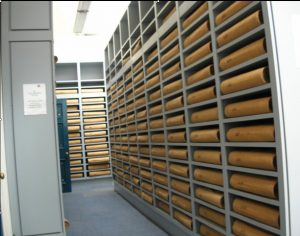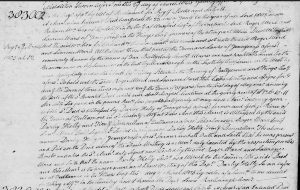
Many veteran researchers have a soft spot for the Registry of Deeds in Dublin. Research here is research as it should be, with much climbing up and down ladders hefting giant hand-written tomes, much poring over 200-year-old legal abbreviations and inhaling 200-year old dust. All that’s missing are the powdered wigs.
But an irksome aspect of recent research there has been the Registry’s official policy on photography. It is utterly bananas.

Every archive balances the contradiction between making records accessible to the public in the present and keeping them safe for the future. And every archive except the Registry has long recognized that encouraging readers to take digital images is a near-perfect answer: it decreases wear and tear on the originals and gives readers a chance to chew over complex records at their leisure. But the Registry bans cameras completely and polices the ban with CC-TV in every research room.

Now FamilySearch.org has rendered the ban moot. So moot, in fact, it couldn’t possibly be mooter. In 1950, the Mormons made a microfilm copy of all of the Registry’s records, Lands Indexes, Grantors’ Indexes, Memorial Books, the lot, all the way from its opening in 1708 to 1929, comprising a massive 2686 microfilms. And they are now digitising the microfilm and making it freely available online. So far, all the Grantors’ and Lands Indexes up to 1929 are complete, all of the eighteenth-century memorial books are complete and about 90% of 1800-1850 memorials are there. The intention appears to be to complete the set.

Hurrah. Almost everything of interest to genealogy is now online, and imaged very well indeed. So much for the camera ban.
Don’t get me wrong. Research on these records remains as cumbersome as it ever was: identify deeds of interest from the indexes; find the matching volume number, then the right page number, then the right memorial. But now, instead of humping 50-pound books up and down ladders, you’re downloading 500 MB microfilm files.
A couple of spin-off implications come to mind. First the heroic volunteer transcription site “Registry of Deeds Index Project Ireland” has depended up to now on its transcribers having physical access to the Mormon microfilms. With direct online access, it should gain hordes of new transcribers and gather serious speed. Hurrah again.
Second, I don’t think I’ll ever breathe that centuries-old dust again. Or maybe ever get out of my dressing-gown.
Dear Mr. Gresham: Because of this seachange in the availability of Memorials of Irish deeds, I have sent a plea to my friends, genealogical and otherwise, to send me a periodic reminder to get and see the light of day! 🙂 All the best, Alison Kilpatrick
I can’t access the collection without either being in a FAmily History Library or having member rights.
Jane –
Can you see this one? I’m not at the FHC today, and I’m not a Church member.
That’s strange. I’m not logged in (in two separate browsers) and have access. It can take a long time for the full 2686 microfilms to appear, though.
Wonderful. I will have to search.
This is fantastic news. I have used them and think it’s a huge step forward, especially for genealogists and researchers who live outside of Dublin. You still need to understand the registry of deeds system but that’s wort doing as there’s so much fascinating and useful information in there that can’t be found anywhere else.
Where is a good place to learn how to use these documents?
Have a look at https://www.irishdeedsindex.net/guides/index.php and https://www.irishdeedsindex.net/guides/fs_navigation.php
Thanks for bringing us up to date on this project. Reading these weekly blogs is better than reading a book on Irish genealogical research. This way we get the very latest dope.
I worked for a year as an indexer on a similar Italian project. Many records there were being threatened by an earthquake in 2009. It was a very rewarding experience. Many now appear in the familysearch.org online collectioon. For details of how to help with indexing as a volunteer go to
https://familysearch.org/indexing/
Thanks for this update. Now take off that dust mask. ?
Thanks John. You’re the ultimate “anorak” with all due respects. Well done and thank you. I’m in awe of your ability and knowledge.
Hi John,
So another set of Irish records bites the dust? Again, we have to thank the Church of latter Day Saints, and not the good old Irish Catholic Church.
Now, you seem to be building a strong and lively following, Is it not the time for you and other Genealogist’s deem it time to join forces and start a campaign to get the government to stop sitting on their hands and start the process to digitize the 1926 census. For I fear that I might be long dead before they the census see the light of day? The 1926 census is the most comprehensive record post war of every man, women and children in Ireland at the time of this census , were every body had to state their home address, County of Birth and their date of birth??
So John, knowing that Ireland loves, and is ruled by referendum’s, is now the time to start a call for for all Ireland to sign a petition to have this the most critically important census, that Ireland has and will ever have.?? To go online ASAP.
Now, if as usual if the Boys up in Dublin castle is short of funds to have this Census Digitized ,I a lowly pensioner is willing to put my hand into my pocket to help out.
Pat Dublin..
That would be a novel approach to genealogical research. I hope that it works.
You can still get copies of the original which can be quite useful, particularly if the original has some words that can not be deciphered